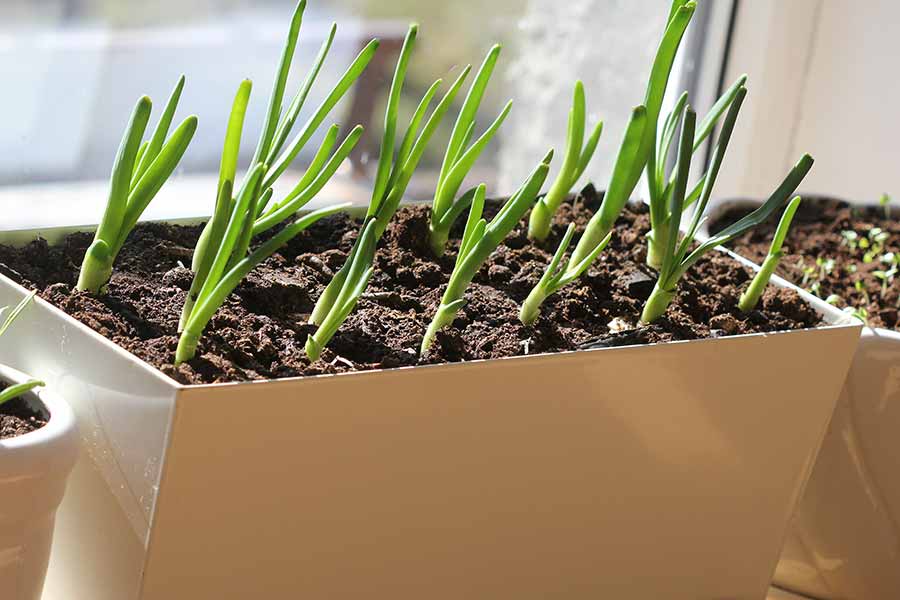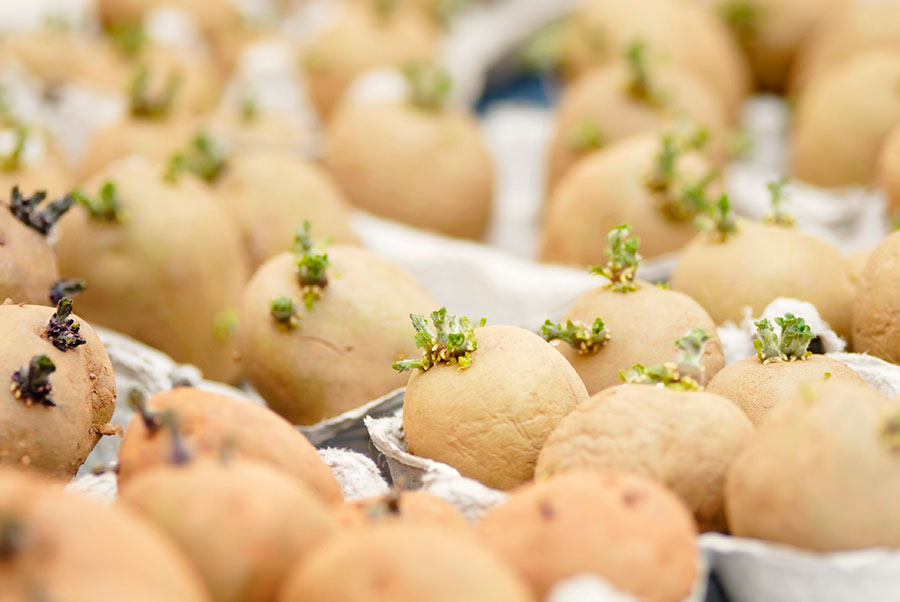- Home
- Leisure & Lifestyle
- Home & Garden
- 10 gardening jobs for February
February is the last month of winter – and with spring on the horizon, there’s plenty we can do to start preparing our gardens for an exciting period of growth!
While February can be one of the coldest months of the year, the days are getting longer and brighter so there’s lots of time to get pruning and sowing.
To help you get started, we’ve put together this list of 10 gardening jobs for February.
1. Prepare seed beds

Though February can be bitterly cold – too cold to sow most seeds directly into the ground – it’s still a good time to start preparing the soil for spring planting.
This means removing weeds; aerating the soil by turning it over with a trowel or fork; and mixing in compost to add nutrients.
Prepared soil can be covered with a cloche to help it stay as warm and dry as possible and prevent it from freezing.
2. Consider what you can sow and grow indoors or under cover

While there are far fewer sowing and growing opportunities this month, there are still some vegetables you can grow under a cloche if you live in a milder area of the UK and have light, sandy soil.
Fruit and vegetables you can sow outside under cover include: broad beans, cabbages, chicory, leeks, parsnips, peas, radishes, and spinach. You can also plant garlic, onions, rhubarb, shallots, raspberry and blackberry canes, and bare root fruit trees (like apples, pears, and plums).
However, if you live in a particularly cold area of the UK and/or have heavier soil in your garden, then it’s worth waiting until the weather warms up to start sowing and growing. Or, if you’re keen to get going, you could sow seeds inside and plant them outside later, to give your spring garden a head start.
3. Plan what you’d like to sow and grow in spring

February is also a great time to think about what you might like to sow and grow in spring, and start preparing.
If you’ve been sowing seeds inside over the winter, it’s worth considering which ones might be mature enough to be planted outside (such as strawberries, onions, and asparagus) once the weather is warm enough.
And, if you’d like some guidance on what can be sown indoors or directly into the ground in March and April, our Rest Less planting calendar – what to sow and grow month by month has plenty of ideas. Some of our favourites are spring onions, sunflowers, and kale.
Once you know what you plan to sow and grow come the spring, it’s worth getting ahead by putting in an order for the seeds online or visiting your local garden centre.
4. Cut back deciduous ornamental grasses

Ornamental grasses add texture, beauty, colour, and interest to any outdoor space from spring all the way through to late winter. They also provide shelter for wildlife, so it’s no wonder why they’re so popular among gardeners.
Ornamental grasses are split into two types – deciduous and evergreen. Deciduous types, such as miscanthus, calamagrostis, molinia, and hakonechloa need cutting back once a year to encourage new growth and help them look their best. They tend to go brown or golden in autumn and winter.
Meanwhile, evergreen types – such as acorus ogon, carex, and mondo grass – retain their colourful foliage year-round and just need an occasional tidy-up.
Around February time, after prolonged exposure to wind, ice, and snow, most deciduous grasses start to look a bit worse for wear and shed their plumes, which can look a little messy. For this reason, a lot of people find it useful to cut grasses back before they start shedding too much.
Cutting them back can also allow more air and light to get to the base of the plant, which makes it easier for new shoots to grow.
For tips on how to cut back ornamental grasses, check out this guide from RHS.
5. Protect blossom on peaches, nectarines, and apricots

Peach, nectarine, and apricot trees can start flowering as early as late February – and new growth and blossoms can be susceptible to frost damage, which can affect the quality of your harvest.
The easiest way to protect these plants is to cover them with a horticultural fleece on nights when frost is forecast.
It can also help to apply mulches (such as garden compost or wood chippings) around fruit trees to warm up the soil. The heat the soil radiates can protect blossoms from frost damage.
To learn more about how to protect fruit trees, have a read of this advice from RHS.
6. Prune shrubs that have finished blooming

If you have any winter-flowering shrubs in your garden, such as viburnum, winter honeysuckle, pansies, snowdrops, and Japanese barberry, these can be pruned if flowering has finished.
Pruning will allow more light and air to reach the base of the plants – so that new shoots and buds can grow, mature, and harden before winter when they’ll bloom once again.
Speaking to Express, Hedges Direct said, “If we first consider the growth cycle of winter-flowering shrubs, it helps us to understand why pruning them at the correct time is so important.
“Winter-flowering shrubs and hedges usually display attractive flowers that last right through the colder months and then begin to sprout new green growth as spring arrives, with flower buds beginning to form that will bloom the following winter.
“As a general rule of thumb, winter-flowering shrubs should be pruned after flowering but before they begin to bud (normally in late winter), as the spring growth that immediately follows will help wounds to heal quickly.”
Summer-flowering shrubs (such as hydrangea, ceratostigma, and giant buddleia) that flower on new growth can also be pruned in February. Doing so will encourage a better flower display later in the year by stimulating growth from dormant buds.
To find out more about how to prune shrubs and use the ⅓ rule, check out this handy page from The Spruce.
7. Chit potatoes

Potatoes should be chitted around six weeks before you intend to plant them, which for many people is around February time.
Chitting is the process of allowing your potatoes to grow sprouts before they’re planted outside. This gives them a head start and cuts down the amount of time you’ll have to wait before they’re fully grown.
Chitting is pretty easy and involves simply placing your potatoes in seed trays or an egg box with their ‘eyes’ facing upwards. They then need to be kept in a cool (but frost-free room) until the sprouts have grown to around 2cm in length, after which time they can be planted outside.
If you’re chitting more than one potato variety, remember to label them.
Gardeners’ World has more information about growing and chitting potatoes if you want to get started.
8. Prune Wisteria

Gardening experts recommend that your wisteria be pruned twice a year – first in January or February and later in July or August.
Pruning wisteria in winter will help to sort out any tangled stems before the growing season when leaf buds begin to open. If you’ve trained your wisteria to grow along a fence, pergola, wall, or arch, February’s also a good time to do any maintenance to these structures or add any extra supports that are needed. This can be much more convenient than doing it later once the plant is heavy with new growth.
Pruning techniques will vary depending on whether your wisteria is young or mature. For example, young wisteria stems can be cut back to around 75cm and untangled from side branches. The rest of the plant can then be cut back by one-third.
In contrast, mature wisteria plants can be cut back to just two or three buds to keep the plant neat and tidy ahead of the upcoming growing season.
For more tips and advice on when and how to prune wisteria, take a look at this advice from Love The Garden.
9. Prune clematis

Like wisteria and other climbing plants, clematis can quickly become a tangled mess if not pruned regularly, so it’s important to know when is best to give it a trim to keep it healthy and looking tidy.
The general rule is that if your clematis flowers in winter or spring, don’t prune it. While if it has large flowers in early summer, you can lightly prune it this month to remove any dead or damaged stems.
If your clematis flowers after June, you can untangle it and cut off the top growth; leaving stems around 50cm long.
To get more tips and advice on pruning your clematis, check out this page from Gardeners’ World.
10. Help local wildlife find food and shelter

February is a bitter month for the UK’s wildlife. Many animals will have gone without food for months and will be weak and hungry. And since some of the coldest winter days may still be yet to come, it’s worth considering what we can do to give wildlife easy access to food and shelter.
For example, you could leave out water and meat-based cat and dog food for hedgehogs. From dusk is best – just remember to cover or remove the leftovers in the morning to prevent maggots. You could also provide hedgehogs with a house to nest in. The Gardeners’ World website has tips on how to make your own hedgehog house, or you can buy one on Amazon.
Many birds start looking for places to raise their young in February too – so you could help by installing a nest box in your garden or cleaning out your current one. You could also leave food in a bird feeder. Black sunflower seeds, fat balls, and cooked rice are great winter foods for birds.
Common gardening advice for February is also to turn your compost heap to get air into the pile, which is thought to boost populations of microorganisms and encourage faster decomposition. But if you want to help out frogs, insects, and small mammals who may be hibernating in your compost, you could avoid turning it until April when the weather’s warmer.
For more tips on how to protect wildlife in the garden you might like to read our article, 11 ways to make your garden more wildlife-friendly. Or, check out the video below from Liz Zorab at Byther Farm.
Final thoughts…
Though it’s been a long, cold winter, there’s something exciting about getting our green spaces ready for the longer, sunnier days. And while there’s plenty to celebrate about winter, most of us welcome spring with open arms – and our gardens do too!
We hope that you’ve found this list of gardening jobs for February helpful. For more gardening tips and advice, why not check out the gardening section of our website?
What jobs are you doing in the garden this month? Did you find any of these tips particularly helpful? We’d love to hear from you in the comments below!
Elise Christian is Lifestyle Editor at Rest Less. She joined Rest Less in 2018 after achieving a first class Master’s Degree in Journalism from the University of Kent, and writes across a range of lifestyle topics such as mental health, home and garden, and fashion and beauty. Prior to this, she worked as a freelance writer for small businesses and also spent a year training to be a midwife. Elise spends her spare time going to the gym, reading trashy romance novels, and hanging out with loved ones. She also loves animals, and has a fascination with sharks and tornadoes.
* Links with an * by them are affiliate links which help Rest Less stay free to use as they can result in a payment or benefit to us. You can read more on how we make money here.
